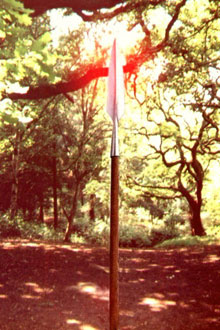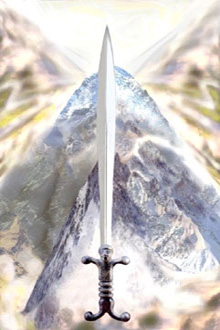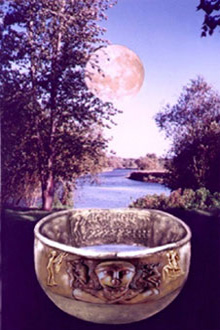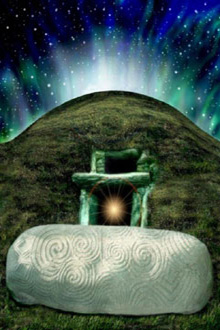|
|
 |
|
|
 |

|
| by Katherine Torres, Ph.D. |
|
 |
|
The Celtic Three Realm Concept
Alexei Kondratiev articulates the three realms of Celtic Paganism in the book, The Apple Branch,
"It is traditional to see a threefold division of the world vertically along the axis of the World Tree. Above us is Sky (nemos),
whence comes our light and everything that promotes clarity and understanding, and where we place the original home of the
gods of the Tribe: this is the realm of order and permanence, of everything that promotes and sustains cultural values. Below
us, encircling the Earth and supporting it, is the realm of Sea (mori), which merges with the watery Underworld: the realm
of darkness and chaos, but also of all fertility; the home of the "antigods" who own the mysteries of Death and Life, and
the home of the ancestors. Where we ourselves stand is the four-sided Earth (terres, talamu), the meeting-place of Above and
Below, and where it is our task to balance out the contradictory influences of the two other realms so that we may survive
and prosper."
According to the Ord Draiochta Na Uisnech website, "The Sea is the time before time, when we are
not born. All life comes from the Sea. It is where we go at death; it is the source of Dreams and Inspiration. It is the realm
that is traveled over to get anyplace when coming from or going to Ireland.
The Land is the here-now. It is this moment, life, and creation, all that is around us. It is fertility,
conscious thought, the Universe. All science fits into the realm of the Land, for it is all concerned with the physical realm.
The Sky is the dwelling place of the Gods, the super-conscious, logic and thought. It is where logical
ideas come from, and it is a place we hope to gain eventually, to become one with the Gods. It is also where Divine Inspiration
comes from."
|
 |
 |
 |
|
|
 |
 |
 |
|
|
|
|
|
 |
 |
All four tarot cards were created by Christopher Taylor Graphic Design




|
Where most Pagans follow the concept of things classified
as being governed by earth, air, fire or water, the Celts tend to classify things as belonging in one of the triad of land,
sea and sky. Some Pagans confuse the traditional Greek four elements with the four treasures of the Tuatha de Danaan
-- The Spear of Lugh, the Sword of Nuadu Airgetlam, the Cauldron of the Dagda and the Stone of Fal. There's a good explanation
of this in Alexei Kondratiev's  The Apple Branch: The Apple Branch:
They are... very reminiscent of the four instruments
-- wand, sword, cup and pentacle -- of the magician in the ceremonial magic tradition, which serve as the four suits of the
Tarot. These represent the Classical elements of fire, air, water and earth, and the human faculties that correspond
to each. There is little evidence to suggest that the theory of the elements was a part of Celtic consciousness before
the Medieval period; yet it is possible to find elemental correspondences for the cities and their Treasures: the names of
Goirias and Muirias clearly associate them with fire and water respectively, and Failias ('the enclosure'), the place of the
Stone, easily stands for earth, which leaves Findias to represent air (in the guise of 'sky'). That these correspondences
by and large agree with the ceremonial magic ones can be both a help and hindrance to circle members who have previous experience
of such traditions. On the one hand, the images of the Treasures and their basic significance will have a familiar feel about
them from the start, allowing immediate identification with their functions; on the other hand, their quarter-attributions
are completely different, and the symbolic system they articulate is based ultimately not on elemental theory but on the Tribe-Land
ideology...
Spear = West = First Function
Sword = North = Second Function
Cauldron = East = Third Function
Stone = South = "Fourth" Function, Land
Each of the Treasures must be wielded by a divine agent in order to be effective,
so we will, in ritual, put them in the care of the God of the corresponding function. The Spear belongs to the Many Gifted
Lord (or Lord of Illumination), the trickster-god who wins by magic and guile rather than by brute strenght, but who also,
because of his superior knowledge of all things, serves as champion and arbiter of society as a whole (this, of course, is
Lugus/Lugh in Celtic Tradition). The Sword belongs to the Lord of Battles, the defender of the Tribe, skilled in fighting
but also in healing, the guardian of the borders of the settled world. The Cauldron (although it is, originally, an attribute
of the Land-goddess) belongs to the Lord of Riches, the fat God of material comfort, who is the direct recipient of the Land's
fertility, and can share it with the Tribe and translate it into wealth. And the Stone, which draws to itself and grounds
the powers of the three functions, belongs, of course, to the Land-goddess herself, the Great Mother on whom all creatures
depend for sustenance, the supreme reality of life on this plane.
|
|
 |
 |
Bendithion Afallon
All pictures on this website are links! Move your cursor over the photo or
art to click the link! I have taken pains to give any work that is not mine credit...please be sure to visit their website!
|
|
|
 |

